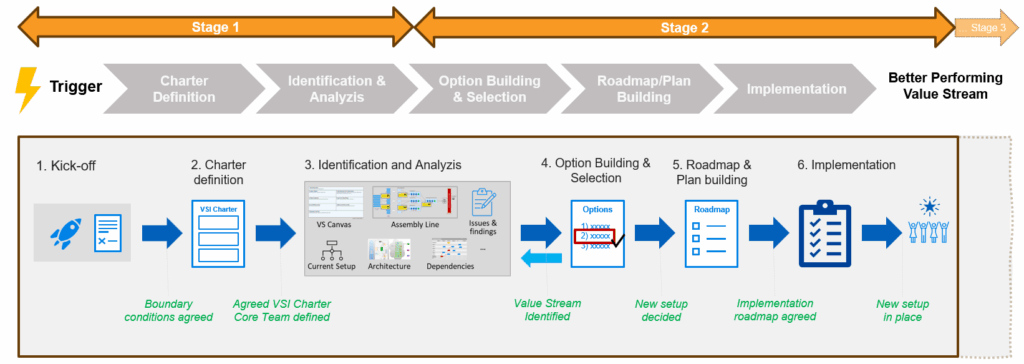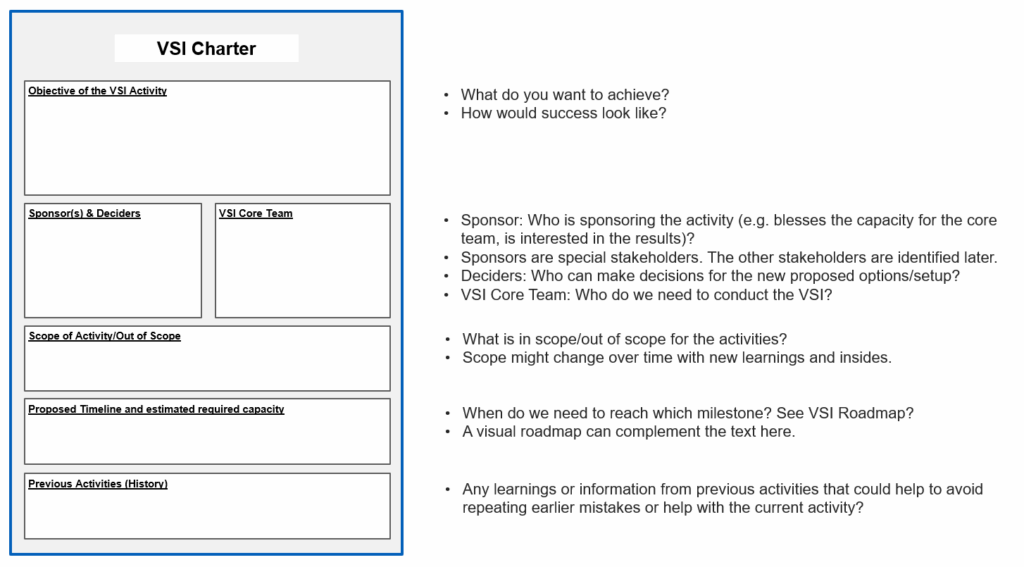How to Start – Single Value Stream
This article offers a practical starting point for organizations seeking to apply Value Stream Thinking. It focuses on a single value stream and deliberately excludes the complexities caused by larger organizations that need to manage many value streams. This simplification allows us to highlight the core process more clearly. For guidance on managing multiple value streams and Value Stream Landscapes in large organizations, read the article Working with Large Value Streams.
How to Start
The starting point for applying Value Stream Thinking is a clear decision — and the sponsorship — to begin working with value streams. This may take the form of an initial pilot or a broader transformation plan targeting a department or the entire organization. Each approach has its strengths and trade-offs, depending on the goals, context, urgency, and level of risk you’re prepared to take. In many cases, transformation activities are already underway elsewhere in the organization – aligning these with the value stream initiative is both necessary and beneficial.
Identification and Setup of a Value Stream
For a single value stream, the journey typically unfolds in three key stages:
Stage 1: Value Stream Identification
Begin by gaining a high-level understanding of the value stream. This involves identifying its most important attributes using tools such as the Value Stream Canvas.
Stage 2: Initial setup of the Value Stream: Organize around Value
Simply identifying a value stream does not create impact on its own. To realize benefits, the identification is typically followed by a new, improved setup – guided by the principle of organizing around value. This may include structural or team changes that better align with the value stream’s flow.
Stage 3: Continuous, systematic improvement of the Value Stream
Once the structure is in place, the focus shifts to continuous optimization – both of the value stream itself and of the methods used to measure its performance. Improving only the existing structure risks achieving only a local optimum. A broader perspective enables movement toward a global optimum. See also Global vs Local Optimum.
The diagram below outlines the key activities involved in Step 1 (Value Stream Identification) and Step 2 (Initial Setup). Step 3, focused on optimization, is covered separately in the article Using the Assembly Line Approach for Value Stream Optimization.

Step 1 – Kick-off: Decision and Assignment
The accountable management team initiates a Value Stream Identification (VSI) effort and assigns initial responsibility to a VSI expert — someone with experience in facilitating VSIs and guiding teams through the process. Since many organizations don’t have this expertise internally at the outset, it is recommended to bring in an external expert to lead the first VSI efforts. This not only ensures a solid start but also creates an opportunity to build internal capability by enabling future in-house experts.
Step 2 – Charter Definition
The expert clarifies the intent and objectives with management and prepares a VSI Charter — translating their expectations into a clear and actionable foundation. Once the charter is aligned with the management team, a core team is formed — including the VSI expert — to carry out the identification process based on the agreed charter.

Step 3 – Identification and Analyzis
Now the real work begins. The core team collects all available artifacts that describe how the product is developed and architected. A central outcome of this phase is the Value Stream Canvas, which provides a clear, concise overview of the key elements of the value stream.
As the team reviews this material – particularly while drafting an initial Value Stream Map – they begin to uncover critical issues in the current implementation. To support this mapping effort, we recommend using the Assembly Line Model, which brings both structure and clarity to the process.
It is almost inevitable that during these discussions, participants uncover current issues and make various observations. These are then documented in the Issues and Findings document.
With this step, we now have a solid understanding of the Value Stream and could, in principle, stop here. However, while we’ve gained valuable insights, nothing has actually changed yet—the situation remains the same. The clarity we’ve achieved can be useful in larger settings, where it helps prioritize where to begin improvements. But in our single Value Stream example, gaining impact requires going further. We should now move on to suggest concrete ways to improve the Value Stream.
Step 4 – Option Building and Selection
Drawing on these insights, the team now can explores potential future-state designs, guided by principles from Team Topologies and the broader goal of organizing around value.
Once potential future-state options have been defined, a Decision Meeting is held. In this meeting, the core team presents its findings on the current state and outlines possible future configurations – highlighting the specific problems each option addresses, the expected benefits, and any potential trade-offs, all grounded in the Issues and Findings list. Based on this input, the management team either selects a preferred option or requests further analysis, alternative proposals, or additional detail before making a final decision.
Step 5 – Roadmap Building
After a decision on the future setup has been made, the next step is to develop an implementation roadmap. This roadmap outlines how and when the new setup will be established and defines the key steps required to achieve it. Once created, the roadmap is presented to the management team for review and approval. Since roadmaps provide a high-level view, they are often followed by a more detailed roll-out plan—depending on the organization’s operating model.
Step 6 – Implementation
Once the roadmap is approved, implementation begins. This includes setting up the new or existing teams, assigning the necessary roles, and defining a working model. Typically, this is guided by a chosen methodology such as Scrum, Kanban, a SAFe ART launch, Scrum@Scale, a Product Operating Model, Nexus, or others.
Conclusion
Starting with a single value stream is a practical entry point into Value Stream Thinking, ideally involving 50–150 people. This article outlines a step-by-step approach — from management commitment and charter creation to mapping, decision-making, and implementation. By dividing the journey into setup and ongoing improvement, organizations can build a solid foundation before scaling. Starting small also helps reduce risk and allows teams to gain valuable experience before applying the approach more broadly. Aligning existing transformation efforts and choosing fit-for-purpose delivery models ensures that value stream initiatives are not just launched, but sustained.
Author: Peter Vollmer – Last Updated on September 10, 2025 by Peter Vollmer
